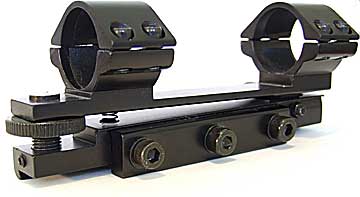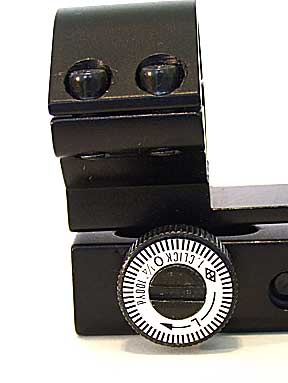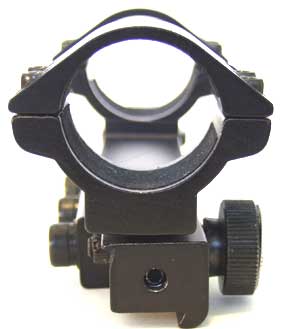by B.B. Pelletier
The BSA adjustable scope mount is a recent development. It promises to solve one of the difficulties encountered with B-Square adjustables, namely that if the elevation has to be adjusted, the scope must be removed from the rings. The design of the BSA mount allows you to leave the scope in the rings, but it introduces another problem that the B-Square mount doesn’t have. I’ll cover that when I come to it. Let’s take a good close look at this new mount.
One-inch, only
Currently this new one-piece mount is issued with one-inch rings, only. So if you have a scope with a 30mm tube you must use something else. And this is a one-piece mount, so you give up some positioning flexibility to use it. But its largest shortcoming is the lack of any kind of built-in scope stop. If you want to use this one on a spring pistol rifle, you must install a secondary scope stop. The combination of that and the limits of a one-piece mount may push the eyepiece too far from your eye. However, because both rings are on the same plate, no amount of elevation adjustment can put any strain on the scope tube.
How does it work?
The mount has an elevation wheel in the rear and a windage knob up front. Of course nothing prevents you from mounting it backwards so those positions are reversed, but since the majority of barrel problems are drooping barrel angles you’ll probably want the elevation at the rear. Refer to the post on barrel droop for a better understanding of the problem.
Elevation
To elevate the rear of the scope, loosen the locking screw and turn the elevation wheel. The upper plate of the mount to which both rings are attached has a spring under it, so it travels as high as the adjustment wheel permits. Locking this wheel freezes all elevation adjustment solid. However, this is where this scope primary flaw is revealed.

The elevation wheel is located at the rear of the mount. The locking screw at the lower rear must be loosened before adjustments can be made. The sharp downward angle shown here is just to illustrate the function. Notice the spring under the scope ring.
Because it has no scope stop of its own and must be butted against a separate stop, the locking screw for the elevation wheel is hidden when the scope mount is butted against the scope stop. So each time you want to elevate or lower the mount, the clamping screws that hold the mount to the dovetails have to be loosened and the scope and mount slid forward to gain access to the locking screw. In practice it’s only a little faster to install than the B-Square mount, plus moving the mount every time means that it needs to be returned to the same place on the rifle each time, or zeroing will take longer. On rifles with short dovetails there is no room to slide it and the procedure amounts to removing the scope and mount from the rifle every time the elevation wheel has to be adjusted. This could easily have been avoided if they had positioned the locking screw on either side instead of at the rear.
Windage
Windage adjusts at the front of the mount, via a knob that looks like it came from a scope. It has click detents and the amount of adjustment (1/4″ per click) inscribed on the outer plate. It has to be unlocked before it will adjust, just like the elevation wheel, only being located at the front means the locking screw is always exposed. This is a great design! It’s much easier to use than the B-Square push-pull windage adjustment screws, and it’s the only one on the market with definite adjustments and click detents.

Windage knob at the front of the mount has click detents, each moving the strike of the round 1/4″ at 100 yards.

Windage dialed all the way to the right (looking back on the mount). It will go just as far in the other direction. The locking screw at the bottom is easily accessible at the front.
Of course when adjusting the front of a scope you want to move the scope in the opposite direction that you want the strike of the pellet to move. It’s the same as adjusting the front sight on an open-sighted gun.
Will it work for you?
The BSA has quite a few limitations that need to be considered before ordering. For starters, it will not work with RWS Diana rifles due to the lack of a vertical scope stop screw. And since it is one-piece, it doesn’t give much scope positioning flexibility. On the other hand, some rifles seem to be made for it – like the Mendozas that have a built-in scope stop the mount can butt up against.
Time will tell if this is a good mount. If any readers have experience with it, please tell us how you like it.
B.B.,
Thanks for looking into this mount for us. I had considered this mount when i purchased my 350M, but the lack of a stop pin was the deal breaker. After seeing your detailed pictures, my idea to drill a hole and thread a small stop pin on the front of the rail was also squashed–there seems to be a grub screw there for locking down the windage adjustment knob. That’s too bad,it seems like it would have been an inexpensive fix for the RWS mounting woes.
On another note, is that B-Square adjustable riser /product/b-square-17011-11mm-to-11mm-riser-base-adjustable?a=299
a new product to Pyramid? I’m sure I haven’t seen it there before. It looks like it might be an alternative (although somewhat awkward)solution to the one-piece adjustables.
Cheers,
Paul Capello
Paul,
No, Pyramyd has stocked that mount base for ten years. It’s an old one. When they sell out of an acceswsory, it diasappears from the website until it’s in stock again.
B.B.
Off topic – experience with my recent acquisitions (RWS 48 and a Gamo CFX) seems to have born out your contention that fixed barrelled guns are less hold sensitive than breakbarrels.
The thing I can’t figure out is – why? When the breach is closed on a breakbarrel, it should act the same as a fixed-barrel gun (as far as the gun is concerned) unless the breach moves when fired – and in that case, I suspect that the gun will NEVER be consistent regardless of hold.
The only other factor I can think of is weight… a heavier gun would tend to move around less while firing. But the CFX isn’t that heavy… and yet it is easier to shoot well than my Shadow. From the standpoint of mechanics the two rifles have many things in common… the stocks are very similar, the trigger is the same, and the powerplant (spring/piston) looks to be identical.
Any clues?
BB
Off Topic – Received my CP99 Ltd Friday. That compensator trick works great, laser sight is fantastic. Very accurate at 16′. Trigger is heavy, but I’m getting used to it. Lots of fun. Thanks
MCA
MCA,
Glad to hear you like it.
B.B.
B.B.,
I just mounted one of these on my B40, but had to drill and tap a hole vertically down thru the base of the mount for a stop screw to line up with one of the stop pin holes in the B40 receiver. It wasn’t that difficult to do but it would have been nice if it were already there.
And for the lock screw on the elevation adjustment, it would have been nice if BSA had tapped a hole from the rear AND from the side, and you could have put the screw in whichever hole was appropriate.
Like we were talking about yesterday, so many missed opportunities by manufacturers to spend a tiny bit more and make a much better product.
Pestbgone
Vince,
I don’t know why this is the case, but it certainly seems to be.
Any clues? Well, nothing exact, but I have felt for a long time that when a break barrel fires, the barrel tries to open a tiny amount. The HW55 and some other target rifles had barrel locks that positively locked the barrel at the breech. These rifles were as accurate as all the fixed barrel target rifles in their day (the 1960s).
The Walther LG55 was a breakbarrel target rifle that had no breech lock, but the even more accurate LGV that used a 55 action and a locked breech surpassed it. These were 9-11 lb. guns, so the weight was there. The only difference was the locked breech.
B.B.
BB, I’ve definitely seen that happen with a couple of breakbarrels, but seems to me that would screw up accuracy regardless of hold. The guns that I had seen with this problem would walk their shots up and down. And if I rested the barrel instead of the forestock, the groups would tighten up considerably.
I really like the locked breach idea, I had one gun that had such a lock. The location of the release was near perfect, and it was almost no effort to pop it open after shooting.
Unfortunately, the rifle was an Industry B2 model… and, well, the less said about them, the better.
the 11mm to Weaver adapter from B-square is an excellent fit for Diana 48 and 52… it allows for droop correction with relative ease, there is a positive stop that hangs in front of the mount on the gun’s receiver, and it allows for weaver rings which have a crossbar to stop creep
I have a question about the quiet pellet trap for you BB. Given regular care and minimal exposure to the outdoors, how many 1000s of shots can I expect before I need to replace the stock putty?
I enjoy reading the reviews and previously inquired about price differences between quality of 2 different GAMO guns. S1000 or Nitro 17. I believe the newer S1000 will price more than the current one(discontinued soon) since it will be outdated due to them using the new plastic barrel shrouds. Less maintenance as well, no rust.
But as much as I enjoy reading(not really), I think it’s time for this site to move into the 21st century and become a Vlog. Because video reviews along with sound, explain far more than words ever can. Just make sure it’s not a crappy webcam or cell phone capture.
Silent pellet trap,
I have a silent trap that I made ten years ago. It has absorbed about 50,000 shots and it still going strong. It has receiver no care whatsoever. In the beginning I tried to clean it, but I soon gave up.
Ask me and I will blog it for you.
B.B.
John,
I’ll have a word with our video department.
B.B.
allowing bloggers to post pic here would be nice also
B.B.
I am interested in silent pellet traps too.
.22 multi-shot
.22 multi-shot,
Okay, I will do them!
B.B.
BB.
What can someone use to raise this mount to allow clearance for a large objective bell?
Thanks
Andreas,
What gun are you mounting the scope on? Does it need a scope stop?
The B-Square riser 11mm extension base will raise your mount base,
but do you need a positive scope stop? It doesn’t have one.
/product/b-square-riser-extension-base-11mm-dovetail?a=1011
B.B.
B.B.,
It’s a 50mm objective bell for a CF-X. I will definately need a good stop block as well.
I believe you remember that the hole for the stop pin on the CF-X is a bit too forward. That’s another problem.
Why is that Riser/Extension Base a TWO piece base??
Also, is a “positive scope stop” any different than a stop block?
Thanks
Andreas,
You do have a problem. I suggest you get high rings instead. Your rifle is not suited to use this extension.
A positive scope stop IS a scope block.
B.B.
B.B.,
Thanks for the heads up.
How come BSA isn’t offering high rings on their adjustable mount? I guess that’s another dissadvantage.
The only reason that I am reluctant on buying B-square adjustables is the possibility of straining the scope tube. It’s unavoidable – I think.
Thanks
Andreas,
B-Square AA mounts installed properly cannot strain a scope tube in any way.
B.B.